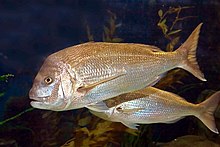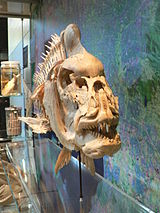Australasian snapper
| Australasian snapper | |
|---|---|

| |
| Australasian snapper, Pagrus auratus, at Melbourne Aquarium .
| |
| Scientific classification | |
| Domain: | Eukaryota |
| Kingdom: | Animalia |
| Phylum: | Chordata |
| Class: | Actinopterygii |
| Order: | Spariformes |
| Family: | Sparidae |
| Genus: | Pagrus |
| Species: | P. auratus
|
| Binomial name | |
| Pagrus auratus (Forster, 1801)
| |

| |
| Distribution of Australasian snapper | |
| Synonyms | |
|
Chrysophrys auratus (Forster, 1801) | |
The Australasian snapper (Pagrus auratus) or silver seabream is a species of
The species name is Chrysophrys auratus, but previously referred to as Pagrus auratus.[1][2]
Regional variation in naming

Australia: cocknies (young smaller than legal size), red bream or pinkies (legal size), squire or squirefish (when bigger), snapper (at full size)
Western Australia: "pink snapper"[3] to distinguish it from unrelated species[4]
Victoria: also schnapper (ref: Schnapper Point, Mornington)
South Australia: the name "ruggers" is often used for smaller fish of legal size
New Zealand: snapper (or New Zealand snapper when there is need to distinguish from other species of snapper). Māori: tāmure (adult fish), karatī (juveniles)[7]
Habitat

The Australasian snapper is found on all coasts of New Zealand, especially in the north. In Australia, it is found along the south coast, mainly near
Growth rates within the wild stocks vary with some (i.e. the Hauraki Gulf, NZ) growing rapidly and to a smaller maximum length, while stocks in east and west Australia are known to grow more slowly. The species is capable of living about 40 years throughout much of its range in Australia, and the Australian recordholder of 40 years and 10 months was a 93.5 cm (36.8 in) large-nosed male, caught on 1 September 2007 off Bunbury, West Australia, and photographed on the day of capture.
In a human context
Snapper was an important traditional food for Māori, especially the tribes to the north of the North Island, where snapper bones sometimes make up the majority of archaeological middens. Snapper is known by multiple names, including tāmure, a word to describe adults, and karatī, a word describing juvenile fish.[11]
There are numerous traditional ways to prepare the fish. One specific to snapper was kaniwha, where the meat would be submerged in fresh water and squeezed numerous times, then eaten raw. The nene (base of the tongue) was considered the most prestigious part of the fish to eat.[11]
Fisheries


Catches of Australasian snapper have varied between 25,600 and 34,300 tonnes in 2000–2009, with Japan and New Zealand reporting the largest catches.[12]
See also
- Cape Woolamai, named after the fish
- Porgie fishing
References
- ^ . Retrieved 11 November 2021.
- ^ a b Froese, Rainer; Pauly, Daniel (eds.) (2012). "Chrysophrys auratus" in FishBase. September 2012 version.
- ^ "Relationships among partial and whole lengths and weights for Western Australian Pink Snapper Chrysophrys auratus (Sparidae) - Department of Fisheries, Western Australia, Fish for the Future". Archived from the original on 19 August 2006. Retrieved 2006-07-22.
- ^ "Fishing Australia with the Definitive Aussie Interactive Sports Fishing Website! - Sportsfish Australia". Archived from the original on 3 July 2006. Retrieved 2006-07-22.
- ISBN 0-19-553099-3
- ^ Matthew Flinders. A Voyage to Terra Australis, volume 1 at Project Gutenberg, entry for 3 May 1802
- ISBN 978-0-9582829-6-3
- ^ a b c Based on data sourced from the FishStat database Archived November 7, 2012, at the Wayback Machine
- Journal of the Royal Society of Western Australia. 93: 129–32.
- ^ Dianne J. Bray & Martin F. Gomon, 2011, Snapper, Chrysophrys auratus, in Fishes of Australia, accessed 09 Sep 2014, http://www.fishesofaustralia.net.au/home/species/678
- ^ Wikidata Q114871191.
- FAO. p. 162. Archived from the original(PDF) on 2017-05-19.
- Allan, Richard (1990). Australian Fish and How to Catch Them. Landsdowne Publishing. ISBN 1-86302-674-6.
- "Snapper". An Encyclopaedia of New Zealand. 1966. Retrieved 2006-07-22.
External links
- Fisheries Western Australia - Pink Snapper Fact Sheet
- Snapper, Fishfiles by Fisheries Research and Development Corporation
- Snapper Fishing Spots in Sydney - Further Information Red Snappers.
- Fishes of Australia : Pagrus auratus

